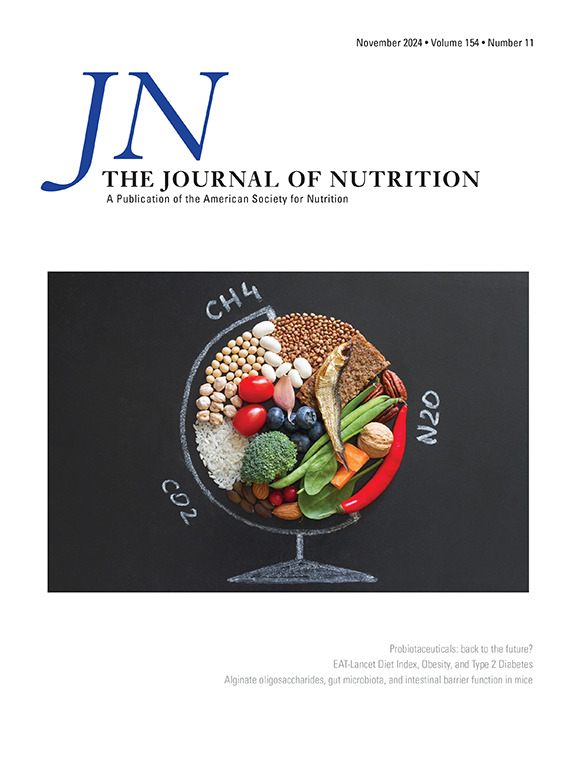由食品级生物聚合物稳定的叶黄素乳液提高了叶黄素的生物利用率,并改善了患有早产儿视网膜病变的新生大鼠视网膜血管形态。
IF 3.8
3区 医学
Q2 NUTRITION & DIETETICS
引用次数: 0
摘要
背景:早产儿视网膜病变(ROP早产儿视网膜病变(ROP)是导致婴儿失明的主要原因,住院的早产儿中有 32% 患有此病。氧化应激是早产儿视网膜病变的主要致病因素,会引发视网膜血管异常新生。叶黄素是一种抗氧化剂,也是黄斑色素的主要成分,在早产儿中含量较低,可能有助于改善早产儿视网膜病变。然而,叶黄素的生物利用率低限制了其作为营养干预措施的应用:本研究旨在评估由食品级生物聚合物稳定的叶黄素乳液对患有视网膜病变的新生大鼠叶黄素生物利用度的影响,并研究未乳化叶黄素和叶黄素乳液对该疾病的影响:新生大鼠在出生后第 7 天和第 8 天(P7 和 P8)皮下注射 KRN 633(10 毫克/千克体重),诱发 ROP。未接受治疗的新生大鼠作为对照。从 P9 到 P21,ROP 大鼠和非 ROP 大鼠被分为三组,每天分别服用橄榄油、未乳化叶黄素(2 毫克/千克体重叶黄素)或叶黄素乳液(2 毫克/千克体重叶黄素)。P22时,收集血清和组织。使用 UPLC 测定叶黄素浓度,并使用免疫组织化学方法评估视网膜形态:结果:接受叶黄素乳剂治疗的大鼠血清和组织中的叶黄素浓度明显高于接受未乳化叶黄素治疗的大鼠。形态学评估显示,ROP 大鼠的动脉更加迂曲,毛细血管密度增加,血管增大,星形胶质细胞密度降低,神经细胞减少。未乳化叶黄素和叶黄素乳液都能缓解这些异常现象,其中叶黄素乳液在使外周视网膜的神经细胞水平恢复正常方面表现出更佳的功效:结论:未乳化和乳化叶黄素都能有效抑制新生大鼠视网膜病变的发展。以生物聚合物为基础的叶黄素乳液有望作为一种给药系统,提高叶黄素的生物利用率并减轻早产儿的视网膜病变。本文章由计算机程序翻译,如有差异,请以英文原文为准。
Lutein Emulsion Stabilized by a Food-Grade Biopolymer Enhanced Lutein Bioavailability and Improved Retinal Vessel Morphology in Neonatal Rats with Retinopathy of Prematurity
Background
Retinopathy of prematurity (ROP) is a leading cause of blindness in infants, affecting 32% of hospitalized preterm infants. Oxidative stress, a primary pathogenic factor in ROP, triggers abnormal neovascularization of retinal vessels. Lutein, an antioxidant and the main component of macular pigment, is found in low levels in preterm infants and may help ameliorate ROP. However, its low bioavailability limits its application as a nutritional intervention.
Objectives
The study aimed to assess the effect of a lutein emulsion stabilized by a food-grade biopolymer on lutein bioavailability in neonatal rats with ROP and examine the effects of both unemulsified lutein and lutein emulsion on the disease.
Methods
Neonatal rats were subcutaneously administered KRN 633 (10 mg/kg body weight) on postnatal days 7 and 8 (P7 and P8) to induce ROP. Neonatal rats that did not receive the treatment served as the control. From P9 to P21, both ROP and non-ROP rats were divided into 3 groups and given daily doses of olive oil, unemulsified lutein (2 mg/kg body weight lutein), or lutein emulsion (2 mg/kg body weight lutein). On P22, serum and tissues were collected. Lutein concentrations were measured using ultra-performance liquid chromatography, and retinal morphology was assessed using immunohistochemistry.
Results
Rats treated with lutein emulsion had significantly higher serum and tissue lutein concentrations than those receiving unemulsified lutein. Morphological assessments showed that ROP rats had more tortuous arteries, increased capillary density, enlarged vessels, reduced astrocyte density, and decreased neuronal cells. Both unemulsified lutein and lutein emulsion alleviated these abnormalities, with lutein emulsion showing superior efficacy in restoring neuronal cell levels to normal in the peripheral retina.
Conclusions
Lutein, in both unemulsified and emulsified forms, effectively inhibited ROP progression in neonatal rats. The biopolymer-based lutein emulsion showed promise as a delivery system to enhance lutein bioavailability and mitigate ROP in preterm infants.
求助全文
通过发布文献求助,成功后即可免费获取论文全文。
去求助
来源期刊

Journal of Nutrition
医学-营养学
CiteScore
7.60
自引率
4.80%
发文量
260
审稿时长
39 days
期刊介绍:
The Journal of Nutrition (JN/J Nutr) publishes peer-reviewed original research papers covering all aspects of experimental nutrition in humans and other animal species; special articles such as reviews and biographies of prominent nutrition scientists; and issues, opinions, and commentaries on controversial issues in nutrition. Supplements are frequently published to provide extended discussion of topics of special interest.
 求助内容:
求助内容: 应助结果提醒方式:
应助结果提醒方式:


